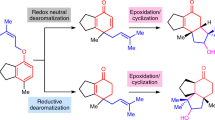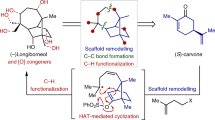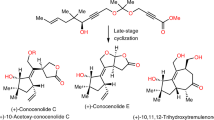Abstract
Terpenes represent one of the largest and most diverse classes of secondary metabolites, with over 55,000 members isolated to date. The terpene cyclase enzymes used in nature convert simple, linear hydrocarbon phosphates into an exotic array of chiral, carbocyclic skeletons. Further oxidation and rearrangement results in an almost endless number of conceivable structures. The enormous structural diversity presented by this class of natural products ensures a broad range of biological properties—ranging from anti-cancer and anti-malarial activities to tumor promotion and ion-channel binding. The marked structural differences of terpenes also largely thwart the development of any truly general strategies for their synthetic construction. This review focuses on synthetic strategies directed toward some of the most complex, biologically relevant terpenes prepared by total synthesis within the past decade. Of crucial importance are both the obstacles that modern synthetic chemists must confront when trying to construct such natural products and the key chemical transformations and strategies that have been developed to meet these challenges.
This is a preview of subscription content, access via your institution
Access options
Subscribe to this journal
Receive 12 print issues and online access
$259.00 per year
only $21.58 per issue
Buy this article
- Purchase on Springer Link
- Instant access to full article PDF
Prices may be subject to local taxes which are calculated during checkout

Similar content being viewed by others
References
Breitmaier, E. Terpenes: Flavors, Fragrances, Pharmaca, Pheromones (Wiley-VCH, Weinheim, Germany, 2006).
Ruzicka, L. Isoprene rule and the biogenesis of terpenic compounds. Experientia 9, 357–367 (1953).
Eschenmoser, A. & Arigoni, D. Revisited after 50 years: the 'stereochemical interpretation of the biogenetic isoprene rule for the triterpenes'. Helv. Chim. Acta 88, 3011–3050 (2005).
Nicolaou, K.C., Vourloumis, D., Wissinger, N. & Baran, P.S. The art and science of total synthesis at the dawn of the twenty-first century. Angew. Chem. Int. Edn Engl. 39, 44–122 (2000).
Nicolaou, K.C. & Sorensen, E.J. Classics in Total Synthesis (VCH, New York, 1996).
Nicolaou, K.C. & Snyder, S.A. Classics in Total Synthesis II (Wiley-VCH, Weinheim, Germany, 2003).
Dewick, P.M. Medicinal Natural Products: A Biosynthetic Approach (Wiley, West Sussex, UK, 2002).
Sierra, M.A. & de la Torre, M.C. Dead Ends and Detours, Direct Ways to Successful Total Synthesis (Wiley-VCH, Weinheim, Germany, 2004).
Dörwald, F.Z. Side Reactions in Organic Synthesis (Wiley-VCH, Weinheim, Germany, 2005).
Corey, E.J. & Cheng, X.M. The Logic of Chemical Synthesis (Wiley, New York, 1995).
Ho, T.-L. Enantioselective Synthesis: Natural Products from Chiral Terpenes (Wiley, New York, 1992).
Jacobsen, E.N., Pfaltz, A. & Yamamoto, H. Comprehensive Asymmetric Catalysis Vols. 1–3 (Springer, New York, 1999).
Newman, D.J. & Cragg, G.M. Natural products as sources of new drugs over the last 25 years. J. Nat. Prod. 70, 461–477 (2007).
Wilson, R.M. & Danishefsky, S.J. Small molecule natural products in the discovery of therapeutic agents: the synthesis connection. J. Org. Chem. 71, 8329–8351 (2006).
Lipinski, C. & Hopkins, A. Navigating chemical space for biology and medicine. Nature 432, 855–861 (2004).
Nicolaou, K.C. & Snyder, S.A. Chasing molecules that were never there: misassigned natural products and the role of chemical synthesis in modern structure elucidation. Angew. Chem. Int. Ed Engl. 44, 1012–1044 (2005).
Hecker, E. Cocarcinogenic principles from the seed oil of Croton tiglium and from other Euphorbiaceae. Cancer Res. 28, 2338–2349 (1968).
Zechmeister, K. et al. Structure determination of the new tetracyclic diterpene ingenol-triacetate with triple product methods. Tetrahedron Lett. 11, 4075–4078 (1970).
Kuwajima, I. & Tanino, K. Total synthesis of ingenol. Chem. Rev. 105, 4661–4670 (2005).
Alder, R.W. & East, S.P. In/out isomerism. Chem. Rev. 96, 2097–2111 (1996).
Funk, R.L., Olmstead, T.A. & Parvez, M. A solution to the in, out-bicyclo[4.4.1]undecan-7-one problem inherent in ingenane total synthesis. J. Am. Chem. Soc. 110, 3298–3300 (1988).
Paquette, L.A., Ross, R.J. & Springer, J.P. Stereocontrolled construction of an ingenol prototype having a complete array of oxygenated and unsaturated centers. J. Am. Chem. Soc. 110, 6192–6204 (1988).
Winkler, J.D., Henegar, K.E. & Williard, P.G. Inside-outside stereoisomerism. 2. Synthesis of the carbocyclic ring system of the ingenane diterpenes via the intramolecular dioxolenone photocycloaddition. J. Am. Chem. Soc. 109, 2850–2851 (1987).
Funk, R.L., Olmstead, T.A., Parvez, M. & Stallman, J.B. Stereoselective construction of the complete ingenane ring system. J. Org. Chem. 58, 5873–5875 (1993).
Rigby, J.H., Bazin, B., Meyer, J.H. & Mohammadi, F. Synthetic studies on the ingenane diterpenes. An improved entry into a trans-intrabridgehead system. Org. Lett. 4, 799–801 (2002).
Winkler, J.D. et al. The first total synthesis of (±)-ingenol. J. Am. Chem. Soc. 124, 9726–9728 (2002).
Tanino, K. et al. Total synthesis of ingenol. J. Am. Chem. Soc. 125, 1498–1500 (2003).
Nickel, A. et al. Total synthesis of ingenol. J. Am. Chem. Soc. 126, 16300–16301 (2004).
Watanabe, K. et al. Formal synthesis of optically active ingenol via ring-closing olefin metathesis. J. Org. Chem. 69, 7802–7808 (2004).
Epstein, O.L. & Cha, J.K. Rapid access to the “in,out”-tetracyclic core of ingenol. Angew. Chem. Int. Ed Engl. 44, 121–123 (2005).
de Mayo, P. Photochemical synthesis. 37. Enone photoannelation. Acc. Chem. Res. 4, 41–47 (1971).
Winkler, J.D., Bowen, C.M. & Liotta, F. [2+2] Photocycloaddition/fragmentation strategies for the synthesis of natural and unnatural products. Chem. Rev. 95, 2003–2020 (1995).
Nicholas, K.M. Chemistry and synthetic utility of cobalt-complexed propargyl cations. Acc. Chem. Res. 20, 207–214 (1987).
Nicolaou, K.C., Bulger, P.G. & Sarlah, D. Metathesis reactions in total synthesis. Angew. Chem. Int. Ed Engl. 44, 4490–4527 (2005).
Wender, P.A. et al. The first synthesis of a daphnane diterpene: the enantiocontrolled total synthesis of (+)-resiniferatoxin. J. Am. Chem. Soc. 119, 12976–12977 (1997).
Jackson, S.R., Johnson, M.G., Mikami, M., Shiokawa, S. & Carreira, E.M. Rearrangement of a tricyclic 2,5-cyclohexadienone: towards a general synthetic route to the daphnanes and (+)-resiniferatoxin. Angew. Chem. Int. Ed Engl. 40, 2694–2697 (2001).
Rigby, J.H. Recent advances in the synthesis of tumor-promoting diterpenes. Stud. Nat. Prod. Chem. 12, 233–274 (1993).
Wender, P.A., Rice, K.D. & Schnute, M.E. The first formal asymmetric synthesis of phorbol. J. Am. Chem. Soc. 119, 7897–7898 (1997).
Nicolaou, K.C., Snyder, S.A., Montagnon, T. & Vassilikogiannakis, G. The Diels-Alder reaction in total synthesis. Angew. Chem. Int. Ed Engl. 41, 1668–1698 (2002).
Brady, S.F., Singh, M.P., Janso, J.E. & Clardy, J. Guanacastepene, a fungal-derived diterpene antibiotic with a new carbon skeleton. J. Am. Chem. Soc. 122, 2116–2117 (2000).
Brady, S.F., Bondi, S.M. & Clardy, J. The guanacastepenes: a highly diverse family of secondary metabolites produced by an endophytic fungus. J. Am. Chem. Soc. 123, 9900–9901 (2001).
Tan, D.S., Dudley, G.B. & Danishefsky, S.J. Synthesis of the functionalized tricyclic skeleton of guanacastepene A: a tandem epoxide-opening β-elimination/Knoevenagel cyclization. Angew. Chem. Int. Ed Engl. 41, 2185–2188 (2002).
Lin, S., Dudley, G.B., Tan, D.S. & Danishefsky, S.J. A stereoselective route to guanacastepene A through a surprising epoxidation. Angew. Chem. Int. Ed Engl. 41, 2188–2191 (2002).
Mandal, M. et al. Total synthesis of guanacastepene A: a route to enantiomeric control. J. Org. Chem. 70, 10619–10637 (2005).
Mehta, G., Pallavi, K. & Umarye, J.D. A total synthesis of guanacastepene C. Chem. Commun. (Camb) 4456–4458 (2005).
Shipe, W.D. & Sorensen, E.J. Convergent, enantioselective syntheses of guanacastepene A and E featuring a selective cyclobutane fragmentation. J. Am. Chem. Soc. 128, 7025–7035 (2006).
Iimura, S., Overman, L.E., Paulini, R. & Zakarian, A. Enantioselective total synthesis of guanacastepene N using an uncommon 7-endo Heck cyclization as a pivotal step. J. Am. Chem. Soc. 128, 13095–13101 (2006).
Miller, A.K., Hughes, C.C., Kennedy-Smith, J.J., Gradl, S.N. & Trauner, D. Total synthesis of (−)-heptemerone B and (−)-guanacastepene E. J. Am. Chem. Soc. 128, 17057–17062 (2006).
Shi, B., Hawryluk, N.A. & Snider, B.B. Formal synthesis of (±)-guanacastepene A. J. Org. Chem. 68, 1030–1042 (2003).
Boyer, F.D., Hanna, I. & Ricard, L. Formal synthesis of (±)-guanacastepene A: a tandem ring-closing metathesis approach. Org. Lett. 6, 1817–1820 (2004).
Maifeld, S.V. & Lee, D. Progress toward the total synthesis of guanacastepene A. Synlett 11, 1623–1644 (2006).
Weinmann, H. & Winterfeldt, E. A predictable enantioselective total synthesis of (+)-clavularin A. Synthesis 1995, 1097–1101 (1995).
Nicolaou, K.C., Bulger, P.G. & Sarlah, D. Palladium-catalyzed cross-coupling reactions in total synthesis. Angew. Chem. Int. Ed Engl. 44, 4442–4489 (2005).
Dounay, A.B. & Overman, L.E. The asymmetric intramolecular Heck reaction in natural product total synthesis. Chem. Rev. 103, 2945–2963 (2003).
Sugano, M. et al. A novel PAF antagonist from a marine fungus Phoma sp. J. Am. Chem. Soc. 113, 5463–5464 (1991).
Goldring, W.P.D. & Pattenden, G. A total synthesis of phomactin A. Chem. Commun. (Camb) 1736–1737 (2002).
Mohr, P.J. & Halcomb, R.L. Total synthesis of (+)-phomactin A using a B-alkyl Suzuki macrocyclization. J. Am. Chem. Soc. 125, 1712–1713 (2003).
Furstner, A. Carbon-carbon bond formations involving organochromium (III) reagents. Chem. Rev. 99, 991–1045 (1999).
Chemler, S.R., Trauner, D. & Danishefsky, S.J. The B-alkyl Suzuki-Miyaura cross-coupling reaction: development, mechanistic study, and applications in natural product synthesis. Angew. Chem. Int. Ed. 40, 4544–4568 (2001).
Chen, K. et al. Anti-AIDs agents—XIX. Neotripterifordin, a novel anti-HIV principle from Tripterygium wilfordii: isolation and structural elucidation. Bioorg. Med. Chem. 3, 1345–1348 (1995).
Corey, E.J. & Liu, K. Enantioselective total synthesis of the potent anti-HIV agent neotripterifordin. Reassignment of stereochemistry at C(16). J. Am. Chem. Soc. 119, 9929–9930 (1997).
Gao, Y. et al. Catalytic asymmetric epoxidation and kinetic resolution: modified procedures including in situ derivatization. J. Am. Chem. Soc. 109, 5765–5780 (1987).
Yoder, R.A. & Johnston, J.N. A case study in biomimetic total synthesis: polyolefin carbocyclizations to terpenes and steroids. Chem. Rev. 105, 4730–4756 (2005).
Mossa, J.S. et al. Saudin, a hypoglycemic diterpenoid with a novel 6,7-secolabdane carbon skeleton, from Cluytia richardiana. J. Org. Chem. 50, 916–918 (1985).
Winkler, J.D. & Doherty, E.M. The first total synthesis of (±)-saudin. J. Am. Chem. Soc. 121, 7425–7426 (1999).
Boeckman, R.K., del Rosario, M., Ferreira, R., Mitchell, L.H. & Shao, P. An enantioselective total synthesis of (+)- and (−)-saudin. Determination of the absolute configuration. J. Am. Chem. Soc. 124, 190–191 (2002).
Labadie, G.R., Cravero, R.M. & Gonzalez-Sierra, M. Studies toward the total synthesis of saudine: simple and stereoselective synthesis of a model caged ketal backbone. Synth. Commun. 26, 4671–4684 (1996).
Labadie, G.R., Cravero, R.M. & Gonzalez-Sierra, M. A short synthesis of the main lactone ketal backbone present in saudin Molecules 5, 321–322 (2000).
Tambar, U.K., Kano, T., Zepernick, J.F. & Stoltz, B.M. Convergent and diastereoselective synthesis of the polycyclic pyran core of saudin. J. Org. Chem. 71, 8357–8364 (2006).
Martin Castro, A.M. Clasien rearrangement over the past nine decades. Chem. Rev. 104, 2939–3002 (2004).
Lindel, T. et al. Eleutherobin, a new cytotoxin that mimics paclitaxel (Taxol) by stabilizing microtubules. J. Am. Chem. Soc. 119, 8744–8745 (1997).
Nicolaou, K.C. et al. Synthesis of the tricyclic core of eleutherobin and sarcodictyins and total synthesis of sarcodictyin A. J. Am. Chem. Soc. 119, 11353–11354 (1997).
Nicolaou, K.C. et al. Total synthesis of eleutherobin and eleuthosides A and B. J. Am. Chem. Soc. 120, 8674–8680 (1998).
Nicolaou, K.C. et al. Total synthesis of eleutherobin. Angew. Chem. Int. Ed Engl. 36, 2520–2524 (1997).
Chen, X.T. et al. A convergent route for the total synthesis of the eleuthesides. Angew. Chem. Int. Ed Engl. 37, 185–186 (1998).
Chen, X.T. et al. The total synthesis of eleutherobin: a surprise ending. Angew. Chem. Int. Ed Engl. 37, 789–792 (1998).
Chen, X.T. et al. The total synthesis of eleutherobin. J. Am. Chem. Soc. 121, 6563–6579 (1999).
Castoldi, D. et al. A formal total synthesis of eleutherobin through an unprecedented kinetically controlled ring-closing-metathesis reaction of a densely functionalized diene. Angew. Chem. Int. Ed Engl. 44, 588–591 (2005).
Tidwell, T.T. Ketenes (Wiley, New York, 1995).
Iimura, S. et al. Terpestacin, a novel syncytium formation inhibitor, isolated from Arthrinium species. Tetrahedron Lett. 34, 493–496 (1993).
Tatsuta, K., Masuda, N. & Nishida, H. The first total synthesis of (±)-terpestacin, HIV syncytium formation inhibitor. Tetrahedron Lett. 39, 83–86 (1998).
Tatsuta, K. & Masuda, N. The first total synthesis of natural (+)-terpestacin, syncytium formation inhibitor. J. Antibiot. (Tokyo) 51, 602–606 (1998).
Myers, A.G., Siu, M. & Ren, F. Enantioselective synthesis of (−)-terpestacin and (−) fusaproliferin: clarification of optical rotational measurements and absolute configurational assignments establishes a homochiral structural series. J. Am. Chem. Soc. 124, 4230–4232 (2002).
Chan, J. & Jamison, T.F. Synthesis of (−)-terpestacin via catalytic, stereoselective fragment coupling: siccanol is terpestacin, not 11-epi terpestacin. J. Am. Chem. Soc. 125, 11514–11515 (2003).
Chan, J. & Jamison, T.F. Enantioselective synthesis of (−)-terpestacin and structural revision of siccanol using catalytic stereoselective fragment couplings and macrocyclizations. J. Am. Chem. Soc. 126, 10682–10691 (2004).
Trost, B.M., Dong, G. & Vance, J.A.A. Diosphenol-based strategy for the total synthesis of (−)-terpestacin. J. Am. Chem. Soc. 129, 4540–4541 (2007).
Nicolaou, K.C., Harter, M.W., Gunzner, J.L. & Nadin, A. The Wittig and related reactions in natural products synthesis. Liebigs. Ann. 1997, 1283–1301 (1997).
Brummond, K.M. & Kent, J.L. Recent advances in the Pauson-Khand reaction and related [2+2+1] cycloadditions. Tetrahedron 56, 3263–3283 (2000).
Corey, E.J., Ohno, M., Mitra, R.B. & Vatakencherry, P.A. Total synthesis of longifolene. J. Am. Chem. Soc. 86, 478–485 (1964).
Barton, D.H.R. The conformation of the steroid nucleus. Experientia 6, 316–320 (1950).
Dyker, G. Handbook of C-H Transformations: Applications in Organic Synthesis Vols. 1–2 (Wiley-VCH, Weinheim, Germany, 2005).
Author information
Authors and Affiliations
Corresponding author
Ethics declarations
Competing interests
The authors declare no competing financial interests.
Rights and permissions
About this article
Cite this article
Maimone, T., Baran, P. Modern synthetic efforts toward biologically active terpenes. Nat Chem Biol 3, 396–407 (2007). https://doi.org/10.1038/nchembio.2007.1
Published:
Issue Date:
DOI: https://doi.org/10.1038/nchembio.2007.1
This article is cited by
-
Transcriptional regulation of trichome development in plants: an overview
Proceedings of the Indian National Science Academy (2021)
-
A general strategy for diversifying complex natural products to polycyclic scaffolds with medium-sized rings
Nature Communications (2019)
-
Innovation in protecting-group-free natural product synthesis
Nature Reviews Chemistry (2019)
-
Sesquiterpene cyclizations catalysed inside the resorcinarene capsule and application in the short synthesis of isolongifolene and isolongifolenone
Nature Catalysis (2018)
-
The Mevalonate Pathway and Terpenes: a Diversity of Chemopreventatives
Current Pharmacology Reports (2018)



